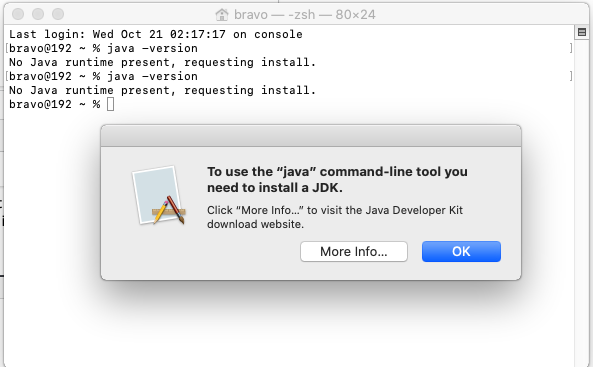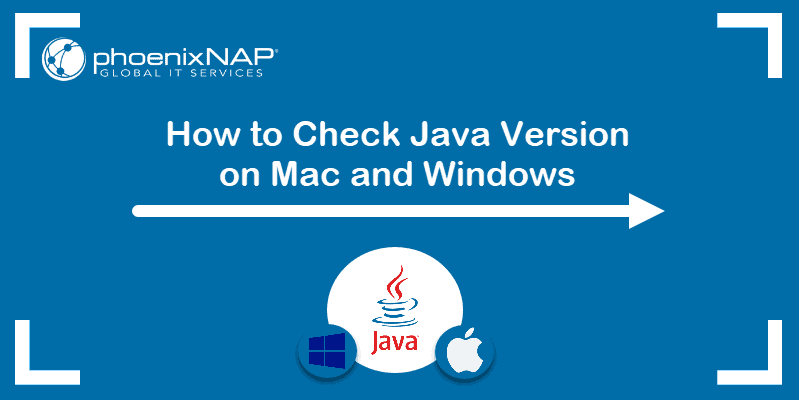

- #Install java on mac command line how to#
- #Install java on mac command line verification#
- #Install java on mac command line download#
- #Install java on mac command line windows#

Go to 'Command Prompt' and type 'java -version' to know the version and.
#Install java on mac command line download#
Open the installer file, and the download begins.
#Install java on mac command line windows#
Move to download section consisting of operating system Windows, and in my case, its Windows Offline(64-bit). To uninstall the JRE on macOS, you must have Administrator’s privileges. Visit Oracles website for the download of the Java Development Kit(JDK). Miscellaneous: You can configure whether to place a Java icon in the system tray under this setting Uninstall JRE on macOS
#Install java on mac command line verification#
Security: Allows you to configure various settings related to security such as grant permissions to content, alert users about site certificates, enable trusted publishers and blacklist revocation checks, use specific SSL and TLS versions, as well as configure mixed code security verification settings. Application Installation: You can enable or disable app installations in this setting. JNLP File/MIME Associations: Allows, disables or prompts user for file associations. Shortcut Creation: Allows you to allow apps or the user to create or disable shortcut creation. Java console: Allows you to show hide or disable the Java console

#Install java on mac command line how to#
HelloWorld.- Debugging: Allows you to enable tracing, logging and show applet lifecyle exceptions. How to Install JDK on Mac OS X Create a directory called myProject under your home directory (Launch Finder Go Home Select File New. We are mapping the local directory with the directory: /usr/src/myapp inside the containerĬreate a docker-compose.yml file: version: "2".Here we are specifying the Java container running version 8 of the SDK ( java:8 - to use Java 7, you could just specify: java:7).Project dependencies are installed within the container - so if you mess up your config you can simply nuke the container and start again.Very easy to switch to different versions of Java by simply changing the tag on the container.No need to set up any version of Java on your local machine (you'll just run Java within a container which you pull from Docker Hub).You can simply run your application within the official JDK container - meaning that you don't have to worry about getting everything set up on your local machine (or worry about running multiple different versions of the JDK for different apps etc)Īlthough this might not help you with your current installation issues, it is a solution which means you can side-step the minefield of issues related with trying to get Java running correctly on your dev machine! To set JAVA_HOME: $ jenv enable-plugin exportĪn option that I am starting to really like for running applications on my local computer is to use Docker. To see all the installed java: $ jenv versionsĪbove command will give the list of installed java: * system (set by /Users/lyncean/.jenv/version)Ĭonfigure the java version which you want to use: $ jenv global oracle64-1.6.0.39 $ jenv add /Library/Java/JavaVirtualMachines/jdk1.11.0_2.jdk/Contents/Home $ echo 'eval "$(jenv init -)"' > ~/.bash_profileĪdd the installed java to jenv: $ jenv add /Library/Java/JavaVirtualMachines/jdk1.8.0_202.jdk/Contents/Home $ echo 'export PATH="$HOME/.jenv/bin:$PATH"' > ~/.bash_profile Install and configure jenv: $ brew install jenv If you want to install/manage multiple version then you can use 'jenv': To install java 8: $ brew cask install adoptopenjdk/openjdk/adoptopenjdk8 To install latest java: $ brew cask install java Install cask (with Homebrew 0.9.5 or higher, cask is included so skip this step): $ brew tap caskroom/cask Why doesn't Oracle's installer put it where it really goes? And how can I work around this problem?Īssumption: Mac machine and you already have installed homebrew. Ironically, the "Java" control panel under System Preferences shows only Java 1.8! usr/libexec/java_home -V still only lists the old Java 1.6. I've tried adding a symbolic link to make it look like 1.8 is in the /System/Library. But /usr/libexec/java_home doesn't find 1.8, so all the posts I've found on how to set your current java version don't work.

Not sure why the latest installer puts this in /Library instead of /System/Library (nor what the difference is). I ran Oracle's Java 8 installer, and the files look like they ended up at /Library/Java/JavaVirtualMachines/jdk1.8.0_05.jdkīut previous versions are at /System/Library/Java/JavaFrameworks/jdk1.6. I'm using IntelliJ 13 CE and Mac OS X 9 Mavericks. I want to do some programming with the latest JavaFX, which requires Java 8. Editors note: This question was asked in 2014, and the answers may be outdated.


 0 kommentar(er)
0 kommentar(er)
